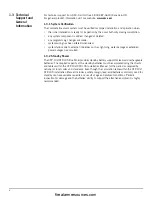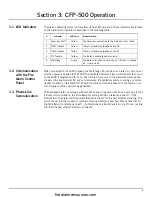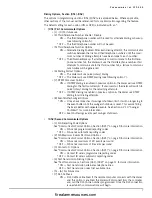
10
SIA
The SIA format communicates information quickly using frequency shift keying (FSK) rather
than pulses. The 2-digit reporting code is used to identify the zone.
SIA Communicator Options [052] #1-2
If the
SIA Sends Automatic Reporting Codes
option is selected, the dialer will automati-
cally generate a reporting code for each event. These identifiers are listed in Appendix A. If
the reporting code [00] is programmed, no transmission will be sent.
If the
SIA Sends Programmed Reporting Codes
option is selected, the dialer will only
communicate events for which valid reporting codes are programmed.
Consult the following table for clarification of this feature:
If the
SIA Sends Maximum of 8 Events per Round
option is enabled, the dialer will limit
its communication round to eight events. This ensures compatibility with all receivers sup-
porting the SIA format. If the
SIA Sends Maximum of 20 Events per Round
, the dialer will
send up to 20 events in one round.
NOTE:
Not all receivers will accept this many events.
Be sure to check the receiver for compatibility.
Pager Format
Events will be communicated to a pager when using this format.
When programming a pager telephone number, extra digits must be used in order for the fea-
ture to function properly. Program two hexadecimal digits ‘E’ at the end of the telephone num-
ber (a 4-second pause). For more information on programming telephone numbers, see
Section 4.2.1 “Telephone Numbers”.
The panel will attempt to call the pager one time. After dialing the digits in the telephone num-
ber the panel will send the account number and reporting code followed by the [#] key (Hex
[C]).
There is no ringback when using Pager format. The panel has no way of confirming if the pager
was called successfully; a failure to communicate trouble will only be generated once the maxi-
mum number of attempts has been reached.
NOTE:
Do not use hexadecimal digit C in a reporting code when using Pager Format. In most
cases, the digit C will be interpreted as a [#], which will terminate the page before it has fin-
ished.
Communication Variables, Sections [081]-[084]
TLM Trouble Delay [081]
This value represents the number of valid checks (10 second interval) required before a tele-
phone line trouble is generated. Valid entries are 000-255, providing trouble annunciation and
transmission delays of 10 to 2550 seconds (42.5 minutes).
AC Trouble Delay [082]
This value represents the time (in hours) the communicator waits upon receiving an AC trouble
condition from a fire control panel before transmitting it. Valid entries are 000-255 where 000
is disabled.
Maximum Dialing Attempts To Each Telephone Number [083]
This value represents the number of attempts that will be made to each telephone number
when communicating. The default value is 007 attempts. Valid entries are 001-015.
Post Dial Wait for Handshake [084]
This value represents the amount of time the communicator will wait for a valid initial hand-
shake from the receiver after dialing the programmed telephone number. The default value is
040 seconds.
Reporting Code Entry
Programmed Reporting Codes
Automatic Reporting Codes
00
No Transmission
No Transmission
FF
No Transmission
Automatic reporting code sent
01-FE
01-FE sent
Automatic reporting code sent
firealarmresources.com
Содержание CFP-500
Страница 31: ...firealarmresources com ...













































